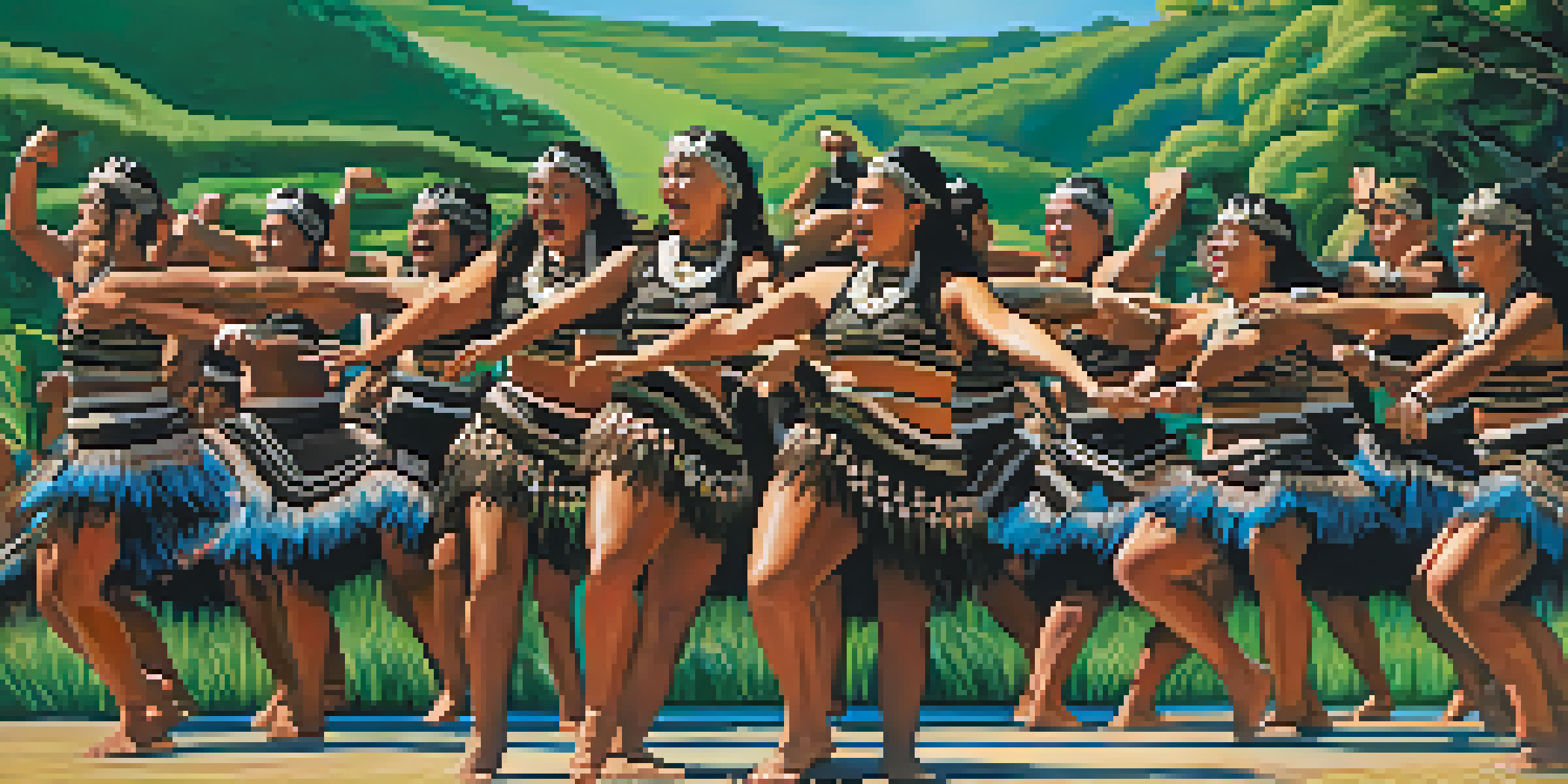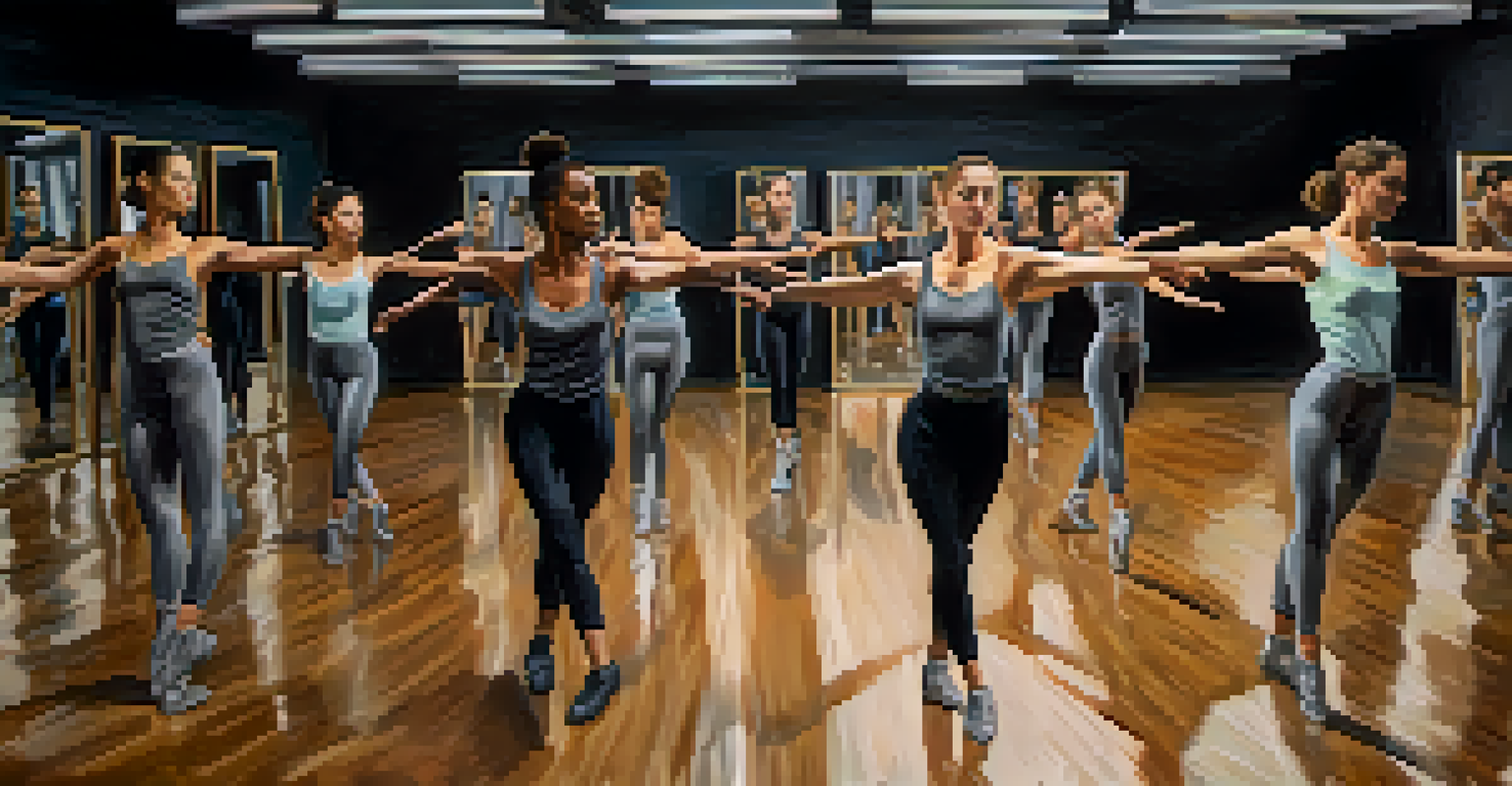Factors Influencing Choreography: Culture, Emotion, and Style

The Role of Culture in Shaping Choreography
Culture serves as a rich tapestry from which choreography draws inspiration. It encompasses traditions, values, and historical contexts that influence how dance is created and performed. For instance, traditional dances like the Maori Haka reflect the cultural identity and history of the Maori people, showcasing their unique storytelling through movement.
Dance is the hidden language of the soul.
Moreover, cultural factors can dictate the themes and techniques used in choreography. A dance inspired by African heritage may incorporate rhythmic footwork and vibrant costumes, while a ballet piece might emphasize grace and precision. These cultural distinctions help to create diverse dance styles that resonate with their respective audiences.
As globalization increases, choreographers often blend elements from various cultures. This fusion not only enriches the choreography but also promotes cultural appreciation and understanding. The result is a dynamic dance scene that continually evolves while honoring its roots.
Emotions: The Heartbeat of Dance
Emotions play a pivotal role in choreography, often serving as the driving force behind the movement. Choreographers tap into their own feelings or experiences to convey messages that resonate with audiences. For example, a contemporary piece might explore themes of love and loss through expressive movements and dramatic dynamics, inviting viewers to connect on a personal level.

Dance is a universal language that transcends words, allowing emotions to flow freely. The way a dancer interprets joy, sorrow, or anger can turn a simple sequence of movements into a powerful narrative. This emotional authenticity is what keeps audiences engaged and invested in the performance.
Culture Shapes Dance Expression
Cultural influences enrich choreography by infusing it with unique traditions and storytelling techniques.
Furthermore, the exploration of emotion in choreography can foster healing and reflection. Many choreographers create works that address social issues or personal struggles, using dance as a means of catharsis. This ability to evoke deep feelings not only enriches the choreography but also fosters a strong connection between the performer and the audience.
The Influence of Style on Choreographic Choices
Dance styles, ranging from classical ballet to hip-hop, significantly influence choreography. Each style has its own set of techniques, movements, and aesthetics that shape the way a piece is created. For instance, a ballet choreographer may focus on intricate footwork and poise, whereas a hip-hop choreographer might prioritize rhythm and improvisation.
Choreography is the art of making dance happen.
Additionally, the stylistic choices made by a choreographer can impact the overall mood and message of a performance. A modern dance piece may use abstract movements to convey a sense of confusion or chaos, while a jazz number might celebrate energy and exuberance. Understanding these stylistic nuances helps choreographers effectively express their artistic vision.
As dance continues to evolve, the blending of styles has become increasingly common. This cross-pollination allows choreographers to experiment with different techniques, resulting in innovative works that challenge traditional boundaries. By embracing diverse styles, choreographers can create fresh and exciting pieces that captivate audiences.
Historical Context: Lessons from the Past
The history of dance is filled with rich narratives that shape contemporary choreography. Understanding historical contexts can provide choreographers with insights into how certain movements or styles emerged. For example, the influence of the feminist movement on modern dance opened doors for female choreographers to express their identities and experiences more freely.
Moreover, historical events often inspire choreography, reflecting societal changes and cultural shifts. A piece inspired by the Civil Rights Movement might incorporate elements of protest and resilience, serving as a powerful reminder of the struggles faced by marginalized communities. This connection to history allows dance to remain relevant and impactful.
Emotions Drive Choreography
Choreographers use personal emotions and experiences to create powerful narratives that resonate with audiences.
Choreographers can draw from past masters, studying their techniques and philosophies to inform their own work. By blending historical influences with contemporary themes, choreographers can create pieces that honor tradition while pushing artistic boundaries. This respect for history enriches the dance landscape and encourages ongoing dialogue.
Personal Experience: The Choreographer's Journey
A choreographer's personal experiences often shape their artistic voice and style. These experiences can range from cultural background to life-changing events, all of which contribute to their unique perspective on dance. For instance, a choreographer who has experienced loss may create a poignant piece that explores themes of grief and healing.
Additionally, the journey of a choreographer involves continuous learning and growth. They may draw inspiration from various sources, including literature, art, or even everyday life, which influences their creative process. This diverse input helps to cultivate a distinctive style that resonates with both the performer and the audience.
Ultimately, a choreographer's journey is a reflection of their identity, allowing them to connect with their audience on a deeper level. By sharing their stories through dance, they can inspire others and foster a sense of community. This personal touch adds richness to the choreography, making it more relatable and impactful.
Collaboration: The Power of Teamwork in Dance
Collaboration is essential in the world of choreography, as it brings together diverse talents and perspectives. Choreographers often work with dancers, musicians, and designers to create a cohesive performance. This teamwork fosters creativity, allowing ideas to flow freely and resulting in a more dynamic piece.
When different artists collaborate, they can blend their unique styles and expertise, leading to innovative choreography. For example, a choreographer might partner with a composer to create a piece that is intricately tied to the music. This synergy enhances the overall experience, captivating the audience and elevating the art form.
Collaboration Enhances Creativity
Working together with diverse artists fosters innovation and leads to dynamic performances that reflect a variety of perspectives.
Moreover, collaboration encourages open communication and trust among team members. This environment allows dancers to contribute their interpretations and ideas, enriching the choreography with diverse voices. By embracing collaboration, choreographers can create works that reflect a broader spectrum of experiences and emotions.
The Future of Choreography: Embracing Change
As the world evolves, so too does the art of choreography. New technologies, societal changes, and cultural shifts are continually influencing how dance is created and performed. Choreographers are increasingly experimenting with virtual reality, multimedia, and interactive elements to engage audiences in fresh ways.
Additionally, the rise of social media and online platforms has transformed the dance landscape, allowing choreographers to reach wider audiences and share their work more easily. This accessibility fosters a diverse range of voices and styles, contributing to a richer dance community that celebrates creativity and innovation.

Looking ahead, the future of choreography promises to be exciting and dynamic. By embracing change and staying open to new ideas, choreographers can push the boundaries of their art form, creating works that are not only relevant but also impactful. This adaptability will ensure that choreography continues to thrive in an ever-evolving world.